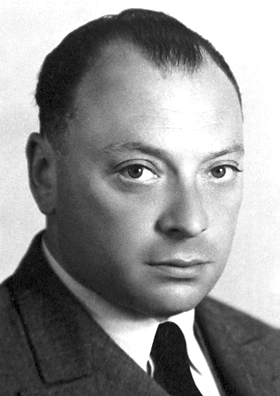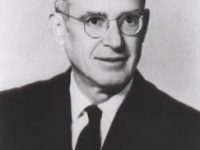
Wolfgang Pauli (1900-1958)
On April 25, 1900, Austrian-born Swiss theoretical physicist Wolfgang Ernst Pauli was born. Pauli is one of the pioneers of quantum theory. In 1945, Pauli received the Nobel Prize in Physics for his “decisive contribution through his discovery of a new law of Nature, the exclusion principle or Pauli principle.” The discovery involved spin theory, which is the basis of a theory of the structure of matter.
“At the dawn of religion, all the knowledge of a particular community fitted into a spiritual framework, based largely on religious values and ideas. “
— Wolfgang Pauli, Statements after the Solvay Conference of 1927, as quoted in Physics and Beyond (1971) by Werner Heisenberg
Wolfgang Pauli – Early Years
Wolfgang Pauli was born in Vienna to a chemist Wolfgang Joseph Pauli and his wife Bertha Camilla Schütz. His middle name “Ernst” was given in honor of his godfather, physicist Ernst Mach, noted for his contributions to physics such as the Mach number and the study of shock waves. Pauli attended the Döblinger-Gymnasium in Vienna and graduated with distinction in 1918. He was certainly not a typical pupil for he read Einstein’s papers on relativity while he was still at the Gymnasium.[1] He attended the Ludwig-Maximilians University in Munich and only two months after graduation, the young prodigy published his first paper, on Albert Einstein’s theory of general relativity. While still an undergraduate at Munich he wrote two further articles on the theory of relativity. In Munich he was working under Arnold Sommerfeld, where he received his PhD in July 1921 for his thesis on the quantum theory of ionized molecular hydrogen.
Reviewing Einstein
Sommerfeld asked Pauli to review the theory of relativity for the Enzyklopädie der mathematischen Wissenschaften (Encyclopedia of Mathematical Sciences). Two months after receiving his doctorate, Pauli completed the article, which came to 237 pages. It was praised by Einstein; published as a monograph, it remains a standard reference on the subject to this day. Einstein wrote in a review:
“Whoever studies this mature and grandly conceived work might not believe that its author is a twenty-one year old man. One wonders what to admire most, the psychological understanding for the development of ideas, the sureness of mathematical deduction, the profound physical insight, the capacity for lucid, systematical presentation, the knowledge of the literature, the complete treatment of the subject matter, or the sureness of critical appraisal.”
From Göttingen to ETH Zürich
Pauli spent a year at the University of Göttingen as the assistant to Max Born, and the following year at the Institute for Theoretical Physics in Copenhagen with Niels Bohr. From 1923 to 1928, he was a lecturer at the University of Hamburg. During this period, Pauli was instrumental in the development of the modern theory of quantum mechanics. In 1924, he formulated the Pauli exclusion principle, perhaps his most important work, which stated that no two electrons could exist in the same quantum state, identified by four quantum numbers including his new two-valued degree of freedom. The idea of spin originated with Ralph Kronig. George Uhlenbeck and Samuel Goudsmit one year later identified Pauli’s new degree of freedom as electron spin. In 1928 he was appointed Professor of Theoretical Physics at the Federal Institute of Technology (ETH) in Zurich and soon made some remarkable progress. In 1926, shortly after Heisenberg published the matrix theory of modern quantum mechanics, Pauli used it to derive the observed spectrum of the hydrogen atom. This result was important in securing credibility for Heisenberg’s theory.
Pauli’s Particle
He predicted mathematically, in 1931, that conservation laws required the existence of a new particle which he proposed to call the “neutron“. In 1933 he made the claim, for the first time, that the particle had zero mass.[2] By that time the nuclear particle that we know today as the neutron had been discovered by Chadwick. Pauli’s particle was named the neutrino by Enrico Fermi in 1934 and at that time he correctly stated that it was not a constituent of the nucleus of an atom. The neutrino was first confirmed experimentally in 1956 by Frederick Reines and Clyde Cowan at Los Alamos, two and a half years before Pauli’s death.
Breakdown
Shortly after Paulis postulation of the neutrino and immediately following his divorce, Pauli had a severe breakdown. He consulted psychiatrist and psychotherapist Carl Jung, who immediately began interpreting Pauli’s deeply archetypal dreams, which Jung documented and published in Psychology and Alchemy. Most of his direct contact was initially with Jung’s student, Erna Rosenbaum, but the two men remained friends and published together on various topics.[3]
“I have done a terrible thing, I have postulated a particle that cannot be detected.”
— Wolfgang Pauli, Statement of 1930, after postulating the existence of the very elusive neutrino; as quoted by Frederick Reines, in his “Foreword” to Spaceship Neutrino (1992) by Christine Sutton, p. xi
World War II and Nobel Prize
In 1926, shortly after Heisenberg published the matrix theory of modern quantum mechanics, Pauli used it to derive the observed spectrum of the hydrogen atom. This result was important in securing credibility for Heisenberg’s theory. After the annexiation of Austria to the German Reich in 1938, Pauli tried in vain to obtain Swiss citizenship and moved to the United States in 1940, where he was employed as a professor of theoretical physics at the Institute for Advanced Study. Pauli did not remain in the United States but he returned to Zurich after World War II to take up his professorship at ETH. In 1945 he was awarded the Nobel Prize in physics, having been nominated for the prize by Albert Einstein.
IIn later years he also returned to general relativity and worked on Kaluza – Klein theories. His ETH lectures from the 1950s were also widely used. By then Pauli’s involvement with philosophy intensified, while travels and epistolary exchanges kept alive his dialogue with Einstein, Bohr, and others. At the age of 58, Wolfgang Ernst Pauli died on 15 December 1958 at the Red Cross Hospital in Zürich, Switzerland.
Alexander Unzicker, The Crisis of Neutrino Physics – a Fictitious Letter by Wolfgang Pauli, [9]
References and Further Reading:
- [1] Wolfgang Pauli Biographical – at Nobelprize.org
- [2] J.J.O’Connor, E.F.Robertson: Wolfgang Ernst Pauli, at The MacTutor History of Mathematics archive, University of St Andrews, Scotland
- [3] Wolfgang Pauli (1900 – 1958) biography at CERN
- [4] Samuel Goudsmit and the Electron Spin, SciHi Blog
- [5] Murray Gell Mann and the Quarks, SciHi Blog
- [6] J.J. Thompson and the Electron, SciHi Blog
- [7] James Chadwick and the Discovery of the Neutron, SciHi Blog
- [8] Wolfgang Pauli at Wikidata
- [9] Alexander Unzicker, The Crisis of Neutrino Physics – a Fictitious Letter by Wolfgang Pauli, Unzicker’s Real Physics @ youtube
- [10] Peierls, Rudolf (1960). “Wolfgang Ernst Pauli 1900–1958”. Biographical Memoirs of Fellows of the Royal Society. Royal Society. 6: 174–192.
- [11] Von Meyenn, Karl (1 February 2001). “Wolfgang Pauli”. Physics Today. 54 (2): 43–48.
- [12] Enz, Charles P. “In memoriam Wolfgang Pauli (1900–1958)”. Helvetica Physica Acta.
- [13] Timeline for Wolfgang Pauli, via Wikidata






Pingback: Whewell’s Gazette: Vol. #45 | Whewell's Ghost
Pingback: Whewell’s Gazette: Year 3, Vol. #37 | Whewell's Ghost